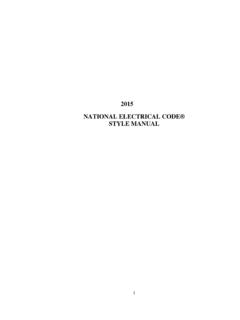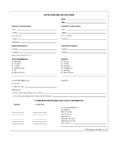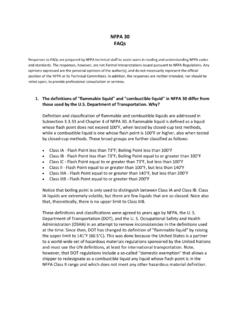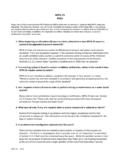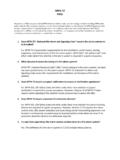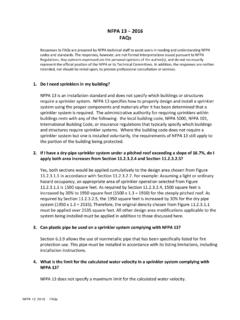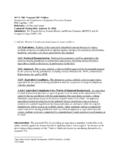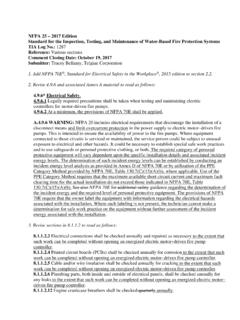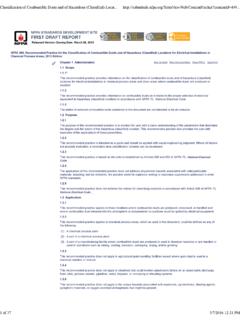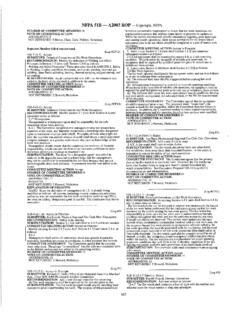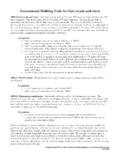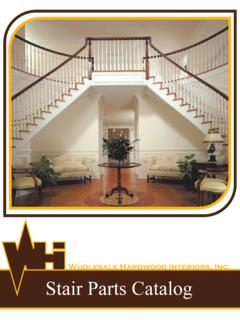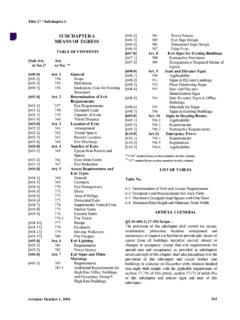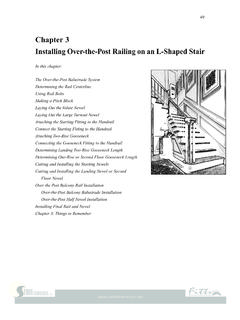Transcription of NFPA 101 FAQs
1 nfpa 101. faqs Responses to faqs are prepared by nfpa technical staff to assist users in reading and understanding nfpa codes and standards. The responses, however, are not Formal Interpretations issued pursuant to nfpa Regulations. Any opinions expressed are the personal opinions of the author(s), and do not necessarily represent the official position of the nfpa or its Technical Committees. In addition, the responses are neither intended, nor should be relied upon, to provide professional consultation or services. 1. Is my building subject to the provisions of the Life Safety code ? The nfpa publishes the Life Safety code using mandatory language that can be adopted . most often legislatively for use in a given jurisdiction. Some government agencies adopt the code administratively and this too has the effect of law within that agency. As a starting point, contact your state fire marshal to help determine if nfpa 101 Life Safety code has been adopted for enforcement in your area.
2 If the code is used, ask which edition. The Life Safety code is published every three years. Local jurisdictions do not always adopt the most recent edition of the example, the Centers for Medicare and Medicaid Services (CMS) and The Joint Commission enforce the 2000 edition on health care occupancies. Visit for information about current and past editions of the Life Safety code . 2. Who is the Life Safety code authority having jurisdiction for my building? The authority having jurisdiction (AHJ) is that person or office charged with enforcing the Life Safety code . In many states the AHJ is the state fire marshal who has local inspectors work on his/her behalf. In some cities, fire department fire prevention division personnel fulfill the role of AHJ; sometimes it is the building official. For some occupancies, there is more than one AHJ; each AHJ's approval must be secured. For example, the authorities having jurisdiction for a hospital might include: state fire marshal; building official; fire department fire prevention officer; state health care licensing agency; The Joint Commission; Department of Health and Human Services Centers for Medicare and Medicaid Services (CMS); and the facility's insurance carrier.
3 If you're unsure who the AHJ is, contact your state fire marshal. 3. I'm putting an addition onto my existing building; where do the Life Safety code requirements for "new" and where do the requirements for "existing" apply? The Life Safety code requires that the addition, itself, meet the requirements for new construction applicable to the occupancy. The existing portion of the building is generally permitted to conform to the requirements for an existing building of its occupancy type. However, there are many special requirements that modify this general rule. For example, if the new construction requirements applicable to the addition mandate a sprinkler system "throughout the building", then sprinklers are required in both the new addition and the existing portion of the building. See nfpa 101, Chapter 43, Building Rehabilitation. 4. Does the Life Safety code require automatic sprinklers in my building?
4 The Life Safety code requires many occupancies especially new construction to be sprinklered. Determine whether the building is subject to the requirements for new construction or those for existing buildings. Go first to the subsection of the applicable occupancy chapter to find any direct mandate for sprinklers. Next, check the subsection under the subject of construction; for some occupancies the building construction type and number of stories can trigger the application of a sprinkler requirement. If the building is high rise, another check should be made in the fourth section of the occupancy chapter because many occupancies require high rise buildings to nfpa 101 faqs be sprinklered-both for new and existing. Also keep track of any alternatives utilized that were offered by the occupancy chapters or the basic, core chapters at the front of the code . For example, many occupancies offer an increase in allowable travel distance if the building is sprinklered.
5 If the travel distance increase is taken, then the sprinkler system is required. As another example, the atrium provisions in the chapter "Fire Protection Features" require an atrium building to be sprinklered. A useful feature of the electronic edition of the National Fire Codes is the search capability; a search for "sprinkler" will quickly locate code text addressing the subject. 5. I have an old sprinkler system that isn't required by the Life Safety code ; can I. shut it down? First, assure yourself that the Life Safety code truly doesn't require the sprinkler system. The use of a code -specified alternative might have invoked a sprinkler requirement. For example, many occupancies offer an increase in allowable travel distance if the building is sprinklered; if the travel distance increase was taken, then the sprinkler system is required. Next, check whether other applicable codes, local ordinances, or insurance company policies require the sprinkler system.
6 If the sprinkler system is not required it can be shut down if sprinklers and control valves obvious to the public are removed. The removal of the equipment is necessary to prevent a false sense of security by building occupants. A typical scenario of concern involves an occupant who mistakenly believing that the sprinkler system is operative doesn't leave the building early in a fire. Provided that the sprinklers are removed, there should be no need to remove the sprinkler system piping provided such piping is concealed within the ceiling cavity. 6. I have a third stair that isn't required by the Life Safety code ; does it need to meet code requirements? The third stair might not be code -required from the standpoint of minimum number of means of egress, or due to an egress width and capacity consideration, or based on a maximum travel distance limitation. Yet, an authority having jurisdiction (AHJ) might claim that the stair is part of the required means of egress for a building occupant who happens to be on the stair at the very instant that the building occupants are notified of a fire.
7 Assuming that the AHJ agrees that the third stair is not required, then the code requirements specifically applicable to stairs do not have to be met. Provisions which are stair -related but address other concepts, such as enclosure so as not to have an unprotected vertical opening, must be met. The designer, for example, could specify that the nonrequired stair have a riser height in excess of that permitted by the code ; but over the life of the building that decision might have repercussions in terms of fall and injury suits and the resulting liability. The designer has little defense when he/she knew to design the two required stairs to the safer dimensions. The noncomplying, nonrequired stair should not be used during emergency egress and relocation drills; the stair should be marked with a sign stating "NO EXIT." Better yet, the stair should be constructed to meet all applicable code provisions.
8 7. Does the Life Safety code require guards on the open side of switch-back stair runs? The Life Safety code requires guards along means of egress paths where there is a vertical drop of at least 30 in. (760 mm). This has particular implication on stairs that historically have required only handrails. Guards must be provided on open sides of the stair including those that "switch back" between adjacent stair flights regardless of horizontal distance between those flights. The minimum 42-in. (1065 mm) high guard, in place of the minimum 34-in. to 38-in. (865-mm to 965-mm) handrail, is needed to prevent the 95 percentile male from falling over the rail upon striking the side of a stair . nfpa 101 faqs On switch-back flights of stairs the required guard is intended to keep a person from falling to the adjacent stair flight. However, the code permits existing guards on existing stairs to be a minimum of 30 in.
9 (760 mm) high. 8. Does the Life Safety code require the doors in my building to swing in the direction of egress travel? Except for a special form of horizontal sliding door and a couple of other exceptions, the Life Safety code requires doors in a means of egress to be of the side-hinged or pivoted- swinging type. Further, the code requires the swinging doors to open in the direction of egress travel under any of four conditions: One, when the door serves a room or area with an occupant load of 50 or more persons; Two, when the door is used in an exit enclosure (such as the door into an enclosed exit stair ); Three, when the door serves a high hazard contents area; and Four, when the door is in a horizontal exit. If none of the four conditions applies, then the door is permitted to swing back into the room or space. 9. How are the Life Safety code provisions applicable to occupant load intended to be applied?
10 The Life Safety code intends for the occupant load expressed in number of persons to be representative of the maximum probable number of persons apt to be present under foreseeable circumstances. Occupant load must consider the maximum probable number of persons because it is used in calculations to assure that the egress system has adequate capacity ( , that it is wide enough) to accommodate everyone at times of emergency egress and relocation. The occupant load is the larger of the two numbers that result from: One, performing a calculation using floor area and a code -specified occupant load factor based on the use of the space; and Two, inquiring of the owner/operator/designer how many people will be present. For some occupancies, such as assembly, the occupant load cannot exceed a calculated value representative of the maximum safe packing of people in a space regardless of how much extra egress width is provided.
